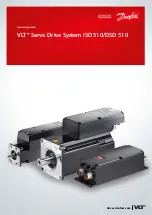
118 Chapter 7 - Parameters Description
User Manual
PID Gains
The enabling of the PID regulator and the selection of two different gains setting, can be carried out via programmable
digital inputs. Below are reported the parameters concerning the gains regulation.
A.050 PID Prop gain 1
(PID proportional gain 1)
Proportional part gain (set 1).
A.051 PID Int t const1
(PID integral constant 1)
Integral action time (set 1).
A.052 PID Deriv gain 1
(PID derivative gain 1)
Derivative action time (set 1).
A.053 PID Prop gain 2
(PID proportional gain 2)
Proportional part gain ( set 2).
A.054 PID Int t const2
(PID derivative gain 2)
Integral action time (set 2).
A.055 PID Deriv gain 2
(PID integral constant 2)
Derivative action time (set 2).
Digital input configuration to select parameter set 1 and set 2.
I.100=21 PID gain sel
Abrupt oscillation caused by the gains selection, can be avoided enabling the function.
PID Integ. Init en ( A.007)
The selection of the two gains setting, is possible programming the digital input as
Pid gain sel
(code 21).
The PID function enabling, is possible programming the digital inputs as
PID Enable
(code 20).
Code
Name
[Code] & Function.
Default
MIN
MAX
Unit
Variation
IPA
A.050 PID Prop gain 1
0
0
99.99
0.01
1209
A.051 PID Int tconst 1
99.99
0
99.99
0.01
1210
A.052 PID Deriv gain 1
0
0
99.99
0.01
1211
A.053 PID Prop gain 2
0
0
99.99
0.01
1212
A.054 PID Int tconst 2
99.99
0
99.99
0.01
1213
A.055 PID Deriv gain 2
0
0
99.99
0.01
1214
PID Limits
A.056 PID high limit
Setting of the maximum allowed PID output.
A.057 PID low limit
Setting of the minimum allowed PID output.
A.058 PID max pos err
(PID maximun positive error)
Setting of the maximum positive limit of the regulator error. It is expressed as percentage of the full scale value.
It defines the threshold for the digital output signalling.
















































